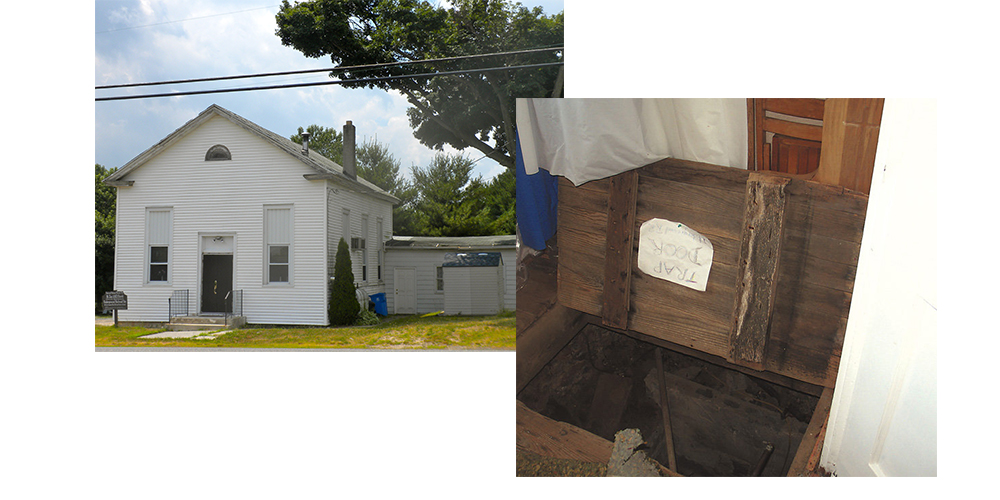WOOLWICH TWP. — Black History Month, observed annually in February, is a significant celebration that aims to honor the achievements, contributions, and struggles of African Americans throughout history. It provides an opportunity to delve into the rich tapestry of African American culture, heritage, and the pivotal role they have played in shaping society.
As we celebrate Black History Month as a community, did you know that there are three historical landmarks that reflect Black History?
In Swedesboro there is Richardson Avenue School which was the state’s last “separate-but-equal” school that served the African American population in the Borough of Swedesboro until 1942.
In Woolwich Township, there is The Mount Zion African Methodist Episcopal (AME) Church and the Mount Zion Cemetery that was an important Underground Railroad station. Members of the Mt. Zion AME church supported the Underground Railroad and actively provided protection, supplies and shelter for runaway slaves.
These landmarks symbolize the enduring spirit and perseverance of African Americans in the face of adversity. They serve as reminders of the ongoing struggle for racial equality and the importance of education and faith in fostering social progress.
There is a lot of history to unfold about the first landmark, Richardson Avenue School. Located at Richardson Avenue and 2nd Street in Swedesboro, the Richardson Avenue School was built in 1931 and was the most recently adapted school for use as a “separate-but-equal” school. It was the building that served as a school for the African American population in the Borough of Swedesboro until 1942.
It is the only segregated school structure still standing in New Jersey and declared as a registered historic landmark. If you are interested in seeing the school or making a donation, you can visit their website: https://www.helpinc.org/
What exactly is a separate-but-equal school?
A separate-but-equal school was a type of educational institution that was established in the United States during the late 19th and early 20th centuries. It was created as a way to legally segregate students based on their race, with the intention of providing equal educational opportunities for both black and white students.
However, in reality, these schools were far from equal.
According to information from the H.E.L.P website, the Richardson Avenue School was constructed for the Mt. Lebanon Lodge of Free and Accepted Masons. The size, location, and limited accommodations in the building caused teachers and 140 children to face inconveniences and dangers. It lacked fire exits, had overcrowded classrooms, limited bathrooms, poor heating and no playground.
The building was condemned in 1940 and finally closed in 1942. Children continued their education at the newly constructed Auburn Avenue School which was the last segregated school built in New Jersey.
According to H.E.L.P., despite the school’s limitations, it had many dedicated teachers, some holding master’s degrees. Many of the students graduated and were successful as doctors, nurses, and educators.
One person that played a significant role in the school’s journey was William B. Gibbs Jr. Gibbs was born in West Chester, Pennsylvania in 1905. He was a Civil Rights activist and pastor with the African Methodist Episcopal Zion Church.
He served as a principal of Auburn Elementary School in Swedesboro. The school is now the Margaret Clifford School. The original building was demolished in 1995. He later served as a junior high school teacher at Kingsway Regional until his retirement in 1971. He passed away in 1984.
In 1936, he became the plaintiff in the case of Gibbs v. Broome, where while teaching in Maryland, he sued the Montgomery County School Board for pay equity discrimination. The case was taken up by Thurgood Marshall, who later became the first black American Supreme Court Justice.
The case was settled out of court in 1937, and over the next two years, black educators in Montgomery County saw their pay rise to parity with white teachers.
This legal victory became one of the cases leading to the landmark Brown v. Board of Education decision, which declared segregated schools unconstitutional.
This leads into the next landmark which William Gibbs was also involved in, The Mount Zion African Methodist Episcopal (AME) Church and Mount Zion Cemetery.
The Mount Zion African Methodist Episcopal Church and Mount Zion Cemetery is located on Garwin Road behind Kingsway Regional High School in Woolwich Township. The church played a significant role in the Underground Railroad. Established in the early 19th century, the church provided a safe haven for runaway slaves with the help of its members, including prominent figures like Harriet Tubman.
The church still has the secret trap door and crawl space that led to a hiding place for slaves. Its circuit preachers were instrumental in guiding and providing shelter for them.
The Underground Railroad was a crucial network in South Jersey. Runaway slaves from states like Virginia, Maryland, and Delaware found refuge in New Jersey, where they were able to escape to Canada and finally find freedom.
Since the 1830’s the Mount Zion Cemetery contains the graves of 13 Civil War soldiers, civil rights activists, and community leaders. However, the cemetery is now threatened by erosion caused by development and farming.
An archaeological study is being done. The report from this study will identify the size of the original cemetery, the number and condition of graves, and makes recommendations for stabilizing the site and preserving the remaining headstones.
Keeping the landmarks and historical sites associated with Black history up to date is crucial in preserving their cultural significance and honoring the legacy of those who fought for racial equality. These landmarks serve as powerful reminders of the struggles and triumphs of the past and are important in educating future generations about the history of African Americans.
by Monica Segeren







